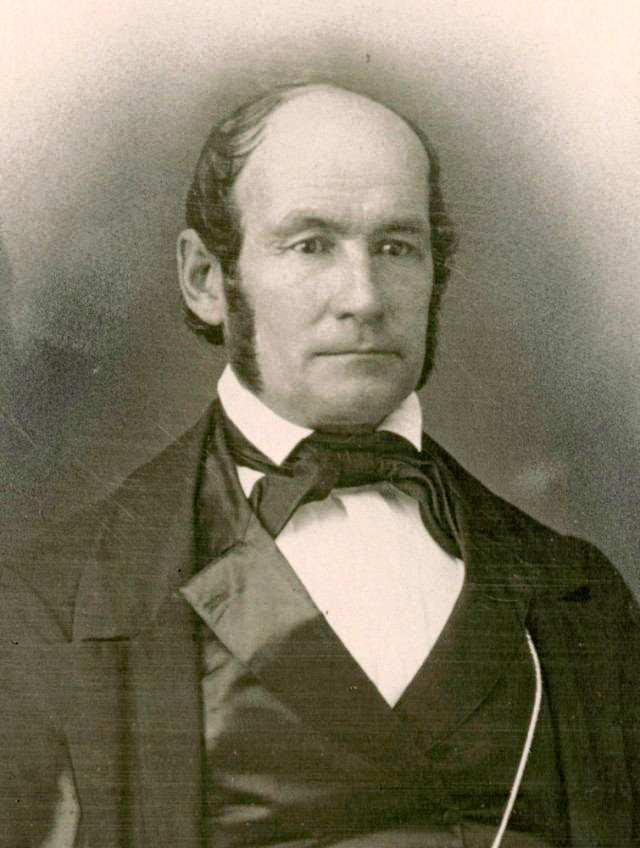Heber Chase Kimball
(1801-1868)


By Susan Easton Black
At age 19 Heber left his parental home to seek his fortune. “I found myself cast abroad upon the world, without a friend,” he wrote. After weeks of hunger from “want of food and the comforts of life,” Heber settled in Mendon, New York and learned the potter’s trade.1 On the evening of September 27, 1827, Heber and his wife and neighbors saw an army engaged in combat in the night sky. He later learned on that September eve the Prophet Joseph Smith received the plates from Angel Moroni.
Heber and his family were baptized members of the Church of Christ and gathered with the Saints to Kirtland, Ohio. In Kirtland, Heber was called to the Quorum of the Twelve Apostles. On June 4, 1837 the Prophet Joseph said to him, “Brother Heber, the Spirit of the Lord has whispered to me ‘Let my servant Heber go to England and proclaim my Gospel, and open the door of salvation to that nation.’” Heber “felt a determination to go at all hazards.”2 He took his journey from Ohio to the New York Harbor where he boarded the Garrick bound for Liverpool. When the Garrick anchored just outside of Liverpool, Heber was transferred to a small boat. “When we were within six or seven feet of the pier, I leaped on shore,” he wrote. “For the first time in my life I stood on British ground, among strangers. I put my trust in God, believing that He would assist me in publishing the truth, give me utterance, and be a present help in time of need.”3
Heber had great success in sharing the Restoration message. For example, after preaching to a gathering in Chatburn, England, he wrote, “I felt some one pulling at my coat, exclaiming, ‘Maister, Maister.’ I turned round and asked what was wanted. Mrs. Elizabeth Partington said, ‘Please sir, will you baptize me?’ ‘And me?’ And me?’ exclaimed more than a dozen voices. Accordingly I went down into the water and baptized twenty-five.”4
After returning to the states, Heber and his family resided in Far West, Missouri, where he met with friends, “some of whom were so glad to see us that tears started in their eyes when we took them by the hand.” From Far West, Heber journeyed to Iowa. In 1840 he served a second mission to England. His testimony did not lessen with the martyrdom of the Prophet Joseph Smith in 1844. He knew the Twelve held “the keys to open up the authority of [the Lord’s] kingdom upon the four corners of the earth” (D&C 124:128). He pressed forward even when faced with the threat of mobbing, the rigors of the Iowa wilderness, and the trek to the Great Salt Lake Valley.
In December 1847 Heber was called to serve in the Presidency of the Church. During his remaining decades, Heber’s life was inseparably connected with Latter-day Saint settlements in the Rocky Mountain region. He served as chief justice and lieutenant governor of the provisional government of Deseret. At the death of his wife in October 1867, Heber said, “I shall not be long after her.” Eight months later, in June 1868 Heber died. At his funeral Brigham Young said, “We can say truly that the day of this man’s death was far better to him than the day of his birth. I have been personally acquainted with him forty three years and I can testify that he has been a man of truth, a man of benevolence, a man that was to be trusted. . . . Brother Heber C. Kimball has been my first counselor for almost twenty-four years. I am happy to state, it is a matter of great joy to me.”5
1. Heber C. Kimball, “Synopsis of the History of Heber Chase Kimball,” Millennial Star 26 (July 23, 1864), p. 471.
2. Orson F. Whitney, Life of Heber C. Kimball, (Salt Lake City: Bookcraft, 1967), p. 104.
3. Ibid, p. 119.
4. Ibid., p. 171.
5. Ibid., pp. 473, 495-496.
